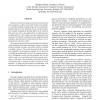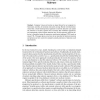58 search results - page 2 / 12 » Detection of New Malicious Code Using N-grams Signatures |
CJ
2004
14 years 10 months ago
2004
Digital signatures have been proposed by several researchers as a way of preventing execution of malicious code. In this paper we propose a general architecture for performing the...
ACSAC
2007
IEEE
15 years 5 months ago
2007
IEEE
Detection of malicious software (malware) by the use of static signatures is often criticized for being overly simplistic. Available methods of obfuscating code (so-called metamor...
INFOCOM
2010
IEEE
14 years 9 months ago
2010
IEEE
Abstract—Malicious shellcodes are segments of binary code disguised as normal input data. Such shellcodes can be injected into a target process’s virtual memory. They overwrite...
SP
2007
IEEE
15 years 5 months ago
2007
IEEE
The integrity of kernel code and data is fundamental to the integrity of the computer system. Tampering with the kernel data is an attractive venue for rootkit writers since malic...
EUROCAST
2007
Springer
15 years 2 months ago
2007
Springer
Abstract. Computer viruses and worms are major threats for our computer infrastructure, and thus, for economy and society at large. Recent work has demonstrated that a model checki...



